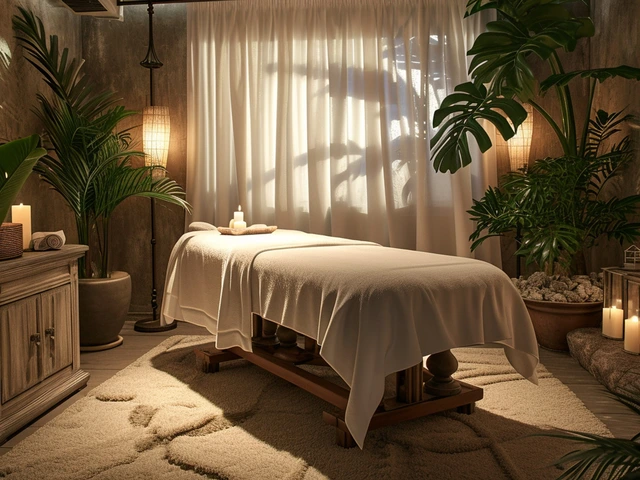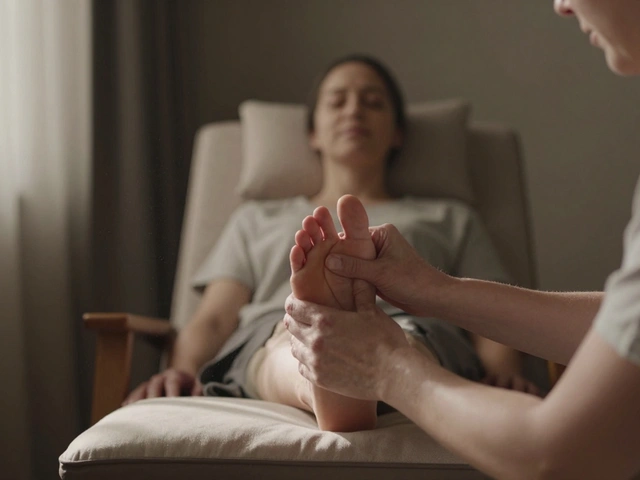Ever felt that tight, bloated sensation in your belly and wondered if there’s something ancient you’re missing? If you’re like me, your gut sometimes feels like it’s running the show—and not always in a good way. There’s a 2,000-year-old secret known as Maya Abdominal Massage. It doesn’t just relax muscles; it shifts things you never knew could move. People walk in with pain and heaviness and walk out lighter, happier, and, sometimes, unexpectedly emotional. No incense or crystals required (unless you want them)—just two hands and a proven technique that might just turn your health around.
Ancient Wisdom Meets Modern Hands
Maya Abdominal Massage has roots that run deeper than your average spa rub-down. Originating with the indigenous healers of Central America, this therapeutic technique was more than a luxury—it was community medicine. For centuries, traditional healers (called sobadoras or sobadores) used their hands to restore flow, balance, and health specifically by working on the abdomen. That’s where many believed the soul and health originated. Modern practitioners, trained in this ancestral art, still use many of the same hand movements—and the results keep speaking for themselves. In fact, Dr. Rosita Arvigo helped bring the practice into the 21st century after spending years with Maya shaman Don Elijio Panti in Belize. They both swore by how physical and emotional blockages are often stored in the belly.
Did you know the gut is our body’s second brain? Science agrees: about 90% of the body’s serotonin, the feel-good chemical, is made right here. That’s probably why Maya healers called the abdomen the home of emotions. Modern researchers now confirm abdominal massage may improve blood flow, lymphatic drainage, and even support the nerve signals between organs. The idea: your organs sometimes fall out of their ‘optimal’ position, especially after accidents, intense exercise, or pregnancy. This massage helps gently move them back, making them work as they should. Sounds wild, but a handful of small studies have shown improvements in period pain, digestion, and even fertility in women using abdominal massage techniques.
Certainly, this isn’t a magic bullet. If you’re dealing with serious pain, you always want to get a medical evaluation. But if you’re looking for a hands-on, non-invasive method to nudge your body into better balance, the Maya approach—using gentle but firm movements—has stood the test of time in ways modern science is just starting to catch up with.
The Gut-Brain Connection: More Than Just a Feeling
Ever wonder why stress messes with your stomach—or why butterflies hit before a big moment? Your gut reacts to almost every emotional shift, and for good reason. The enteric nervous system (yep, that’s a real thing!) is like a mini brain inside your abdomen. It manages digestion but also chats non-stop with your main brain. When things aren’t right in one, the other feels it.
Here’s something most people don’t realize: abdominal massage is one of the fastest ways to calm the nervous system. When you work out those knots and adhesions, the nervous system gets the memo to dial down fight-or-flight mode. People report feeling physically lighter, but also emotionally clearer—some walk away with unexpected tears, laughter, or just a quiet buzz in their bones.
For folks with IBS, endometriosis, or unexplained bloating, studies from 2017 and 2019 out of the UK and Brazil tracked people receiving abdominal massage and found notable drops in pain and anxiety levels after just a handful of sessions. It’s not just what’s happening with your organs; it’s chemical and neurological. This stuff can lower cortisol—the stress hormone—relieve constipation, and ease cramps. No special equipment needed.
Here’s a quick table to show what recent research found about abdominal massage effects:
| Condition | Massage Benefit | Study Year |
|---|---|---|
| IBS (Irritable Bowel Syndrome) | Decreased bloating, improved gut motility | 2019 |
| Menstrual pain | Reduction in cramping and lower-back pain | 2017 |
| Constipation | Faster bowel movement transit times | 2018 |
| Anxiety | Lower baseline cortisol after 4 sessions | 2017 |
If you’ve ever dismissed a stomach massage as just pampering, maybe give nature’s mechanism a second look. It’s pretty wild how working from the outside in, you can turn the volume way down on the body’s anxiety, pain, and tension circuits.

Fertility & Menstrual Cycles: The Uterus Gets a Reset
Women’s health is where Maya Abdominal Massage has made some of the most dramatic headlines. Uterine position matters more than most realize. A slightly tilted, prolapsed, or out-of-place uterus can cause heavy periods, painful sex, frequent urination, or even trouble getting pregnant. Many OB-GYNs still don’t check for these subtle shifts. But Maya practitioners have sharper hands than most doctors’ tools—they palpate to sense what’s out of line and coax it gently back into place.
It’s not just old lore. A 2021 clinical observation published in the Journal of Integrative Medicine found that women using external abdominal massage, including the Maya method, had a 24% improvement in cycle regularity and a 19% rise in natural conception rates compared to those receiving standard care. And you don’t need to be trying to get pregnant to notice changes. Women regularly say cycles get lighter, cramps ease up, and digestive symptoms calm down alongside hormonal balancing.
The technique involves far more subtlety than pushing or jabbing. Practitioners combine rhythmic strokes, circular movements, and gentle lifting to target the ligaments, muscles, and fascia supporting the womb. Don Elijio always said, “If a woman’s uterus is out of balance, her life is out of balance.” Modern science is just catching up. The big kicker? Most folks can learn to do a basic version on themselves at home for maintenance in between sessions. Money saved. Body empowered. Win-win.
For women dealing with endometriosis, PCOS, or unexplained infertility, this approach is worth a try. It won’t replace your doctor, but it could do that little bit extra science sometimes can’t explain. As for side effects, you might just find yourself needing a tissue or two for emotions that pop up out of nowhere. That’s the body clearing not just physical, but old emotional baggage too.
How a Session Works: What to Expect and Key Tips
Walking into a session feels a bit different than a typical massage space. There might be herbs, calming music, and a practitioner who spends a lot of time asking about your digestion, cycle, back pain, energy, even your mood. It feels more like a health detective meeting than a massage booking.
You’ll usually lay back comfortably with pillows tucked every which way. Then, the practitioner applies plant-based oil and starts with gentle strokes around the belly, moving in time with your breath. Gradually, the pressure gets deeper, but it never feels rough or intrusive. They might ask you to inhale or exhale at certain moments, helping guide the organs gently into better alignment.
- Wear comfy, loose clothes—you don’t want anything digging into your middle.
- Don’t eat a huge meal first. A light snack is fine, but a full stomach can make it uncomfortable.
- If possible, journal symptoms before and after. People often forget which weird aches or moods suddenly disappear.
- Expect the practitioner to teach you a simple self-massage for maintenance between sessions.
- Hydrate like crazy afterward; your lymph system and digestion will kick into high gear.
Your first session might bring up some new digestive movement or even spark emotions. It’s a good idea to have some downtime planned for afterward (think a quiet walk or chill evening, not an all-out gym bash). People are often surprised by the emotional release; even stubborn ‘I-never-cry’ types sometimes mist up at the end. If you feel woozy or tired, that’s normal—a natural sign your nervous system is resetting.

Bringing Maya Massage Home: DIY Techniques and Cautions
Want to try a taste of the magic at home? Good news—it’s safe for most people and easy to learn a light, basic version. But don’t replace a trained healer’s hands if you have any medical conditions like fibroids, IUDs, freshly healed surgeries, or if you’re trying to get pregnant (in those cases, check with your provider).
- Lie back on your bed with a small pillow under your knees. Expose your belly, applying a bit of unscented oil or lotion.
- Warm your hands by rubbing them together. Gently rest both on your abdomen, focusing on slow, deep breaths.
- Make small circles around your belly button using your fingertips. Move in a clockwise direction—this matches your colon’s path.
- With one hand upwards near your lower ribs, gently but firmly glide downward toward your pelvis in smooth, rhythmic strokes. Alternate hands.
- Spend extra time on any tight, tender, or cool areas. These usually correspond to tension or stagnation. Be gentle—if it hurts, lighten up.
- Finish by resting your palms over your lower abdomen and breathe slowly for a full minute, letting your belly rise and fall.
Repeat this simple routine a few nights a week. Most people begin to notice bloating, cramping, or sluggishness ease off after just a handful of sessions. If you do feel pain that doesn’t resolve, or things get worse, stop and check with a health pro.
The real magic of Maya Abdominal Massage is its ability to bring people back to their center—literally and emotionally. Ancient hands knew that life’s messes often start in the gut, and somehow, 2,000 years later, we’re still discovering that truth. Chronic cramps, bloating, fertility struggles, or emotional baggage hiding under your ribs? Don’t write it off. A simple practice, rooted in old wisdom and sprinkled with new research, might just give you the reset you didn’t know you needed.







